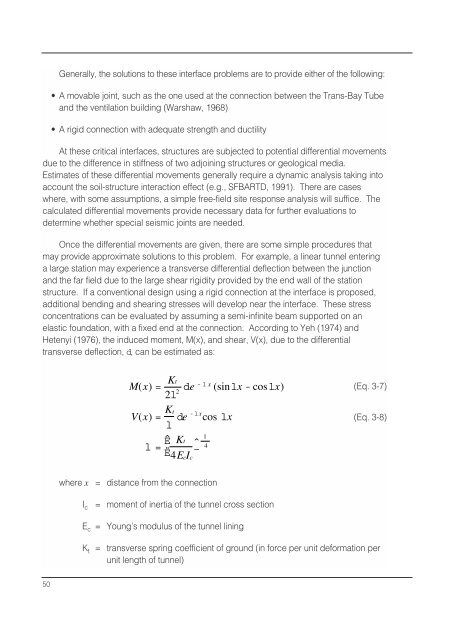Seismic Design of Tunnels - Parsons Brinckerhoff
Seismic Design of Tunnels - Parsons Brinckerhoff
Seismic Design of Tunnels - Parsons Brinckerhoff
You also want an ePaper? Increase the reach of your titles
YUMPU automatically turns print PDFs into web optimized ePapers that Google loves.
Generally, the solutions to these interface problems are to provide either <strong>of</strong> the following:<br />
• A movable joint, such as the one used at the connection between the Trans-Bay Tube<br />
and the ventilation building (Warshaw, 1968)<br />
• A rigid connection with adequate strength and ductility<br />
At these critical interfaces, structures are subjected to potential differential movements<br />
due to the difference in stiffness <strong>of</strong> two adjoining structures or geological media.<br />
Estimates <strong>of</strong> these differential movements generally require a dynamic analysis taking into<br />
account the soil-structure interaction effect (e.g., SFBARTD, 1991). There are cases<br />
where, with some assumptions, a simple free-field site response analysis will suffice. The<br />
calculated differential movements provide necessary data for further evaluations to<br />
determine whether special seismic joints are needed.<br />
Once the differential movements are given, there are some simple procedures that<br />
may provide approximate solutions to this problem. For example, a linear tunnel entering<br />
a large station may experience a transverse differential deflection between the junction<br />
and the far field due to the large shear rigidity provided by the end wall <strong>of</strong> the station<br />
structure. If a conventional design using a rigid connection at the interface is proposed,<br />
additional bending and shearing stresses will develop near the interface. These stress<br />
concentrations can be evaluated by assuming a semi-infinite beam supported on an<br />
elastic foundation, with a fixed end at the connection. According to Yeh (1974) and<br />
Hetenyi (1976), the induced moment, M(x), and shear, V(x), due to the differential<br />
transverse deflection, d, can be estimated as:<br />
M(x) = Kt<br />
2l 2 de -lx (sinlx - coslx)<br />
(Eq. 3-7)<br />
V(x) = K t<br />
l de<br />
Ê Kt<br />
l=<br />
ˆ<br />
Ë4E c I c<br />
¯<br />
-lx cos<br />
1<br />
4<br />
lx<br />
(Eq. 3-8)<br />
where x<br />
I c<br />
= distance from the connection<br />
= moment <strong>of</strong> inertia <strong>of</strong> the tunnel cross section<br />
E c = Young’s modulus <strong>of</strong> the tunnel lining<br />
K t<br />
= transverse spring coefficient <strong>of</strong> ground (in force per unit deformation per<br />
unit length <strong>of</strong> tunnel)<br />
50
















